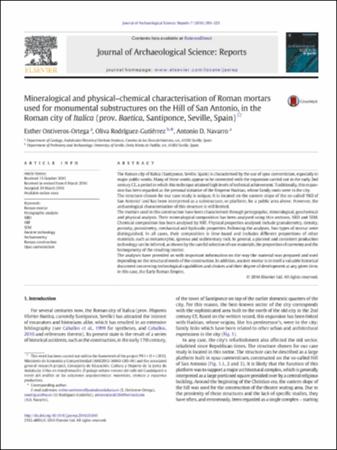
.jpg)
REPOSITORIO DE ACTIVOS DIGITALES
Depósito de documentos digitales reúne, difunde y preserva la documentación generada en los proyectos y actividades del Instituto Andaluz del Patrimonio Histórico.
https://hdl.handle.net/11532/300390
| Title : | |
| Author : | Ontiveros Ortega, Esther Rodríguez Gutiérrez, Oliva Navarro Martínez, Antonio David |
| Date issued: | 2016 |
| Source: | Journal Archaeological Science, 2016, vol.7, pp. 205-223 |
| Document Type: | Artículo publicación periódica |
| Heritage asset: | Ciudad romana de Itálica (4607) |
| Describe in detail: | https://guiadigital.iaph.es/bien/inmueble/4607 |
| Province: | Sevilla |
| Municipality: |  Santiponce Santiponce |
| Thematic descriptors: | Patrimonio arqueológico Mortero Piedra Técnica de construcción Química Arte romano |
| Language ISO: | eng |
| Abstract: | The Roman city of Italica (Santiponce, Seville, Spain) is characterised by the use of opus caementicium, especially in major public works. Many of these works appear to be connected with the expansion carried out in the early 2nd century CE, a period in which this technique attained high levels of technical achievement. Traditionally, this expansion has been regarded as the personal initiative of the Emperor Hadrian, whose family roots were in the city. The structure chosen for our case study is unique. It is located on the eastern slope of the so-called ‘Hill of San Antonio’ and has been interpreted as a substructure, or platform, for a public area above. However, the archaeological characterisation of this structure is still limited. The mortars used in this construction have been characterised through petrographic, mineralogical, geochemical and physical analysis. Their mineralogical composition has been analysed using thin sections, XRD and SEM. Chemical composition has been analysed by XRF. Physical properties analysed include granulometry, density, porosity, porosimetry, mechanical and hydraulic properties. Following the analyses, four types of mortar were distinguished. In all cases, their composition is lime-based and includes different proportions of other materials, such as metamorphic, igneous and sedimentary rock. In general, a planned and consistent production technology can be inferred, as shown by the careful selection of raw materials, the proportion of caementa and the homogeneity of the resulting mortar. The analyses have provided us with important information on the way the material was prepared and used depending on the structural needs of the construction. In addition, ancient mortar is in itself a valuable historical document concerning technological capabilities and choices and their degree of development at any given time, in this case, the Early Roman Empire. |
| Publisher : | Elsevier |
| ISSN: | MIAR 0305-4403 |
| Rights: | © Instituto Andaluz del Patrimonio Histórico |
| Rights URL: | https://creativecommons.org/licenses/by-sa/4.0/deed.es |
| Date accessioned: | 2016-09-01T11:56:22Z |
| Date available: | 2016-09-01T11:56:22Z |
| Format: | application/pdf |
| URI: | http://hdl.handle.net/11532/300390 |
| Appears in Collections: | Artículos en publicaciones seriadas |
| File | Description | Size | Format | |
|---|---|---|---|---|
| Mineralogical_and_physicalxchemical_characterisation_of_Roman_mortars_in_Italica.pdf | 8,13 MB | Adobe PDF |  View |
Items from IAPH are protected by copyright, all rights reserved, unless otherwise indicated.
Export item
Related Items
Rodríguez Gutiérrez, Oliva; Ontiveros Ortega, Esther; Loza Azuaga, Maria Luisa; Taylor, Ruth; Beltrán Fortes, José; Rodríguez Azogue, Araceli
Rodríguez Gutiérrez, Oliva; Taylor, Ruth; Beltrán Fortes, José; García-Dils de la Vega, Sergio; Ontiveros Ortega, Esther; Ordóñez Agulla, Salvador
Rodríguez Gutiérrez, Oliva; Mañas Romero, Irene; Ontiveros Ortega, Esther
Ontiveros Ortega, Esther; Beltrán Fortes, José; Taylor, Ruth; Rodríguez Gutiérrez, Oliva; López Aldana, Pedro
Ordóñez Agulla, Salvador; Taylor, Ruth; Rodríguez Gutiérrez, Oliva; Ontiveros Ortega, Esther; García-Dils de la Vega, Sergio; Beltrán Fortes, José; Saquete Chamizo, José Carlos








